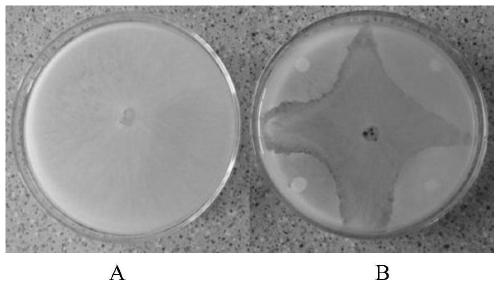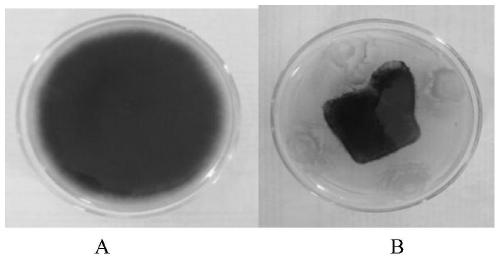Bacillus subtilis strain NH-6 and application thereof
A technology of Bacillus subtilis and NH-6, which is applied in the direction of application, bacteria, and fungicides, can solve the problems of unsatisfactory effect and single plant disease control effect, and achieve strong stress resistance, simple cultivation method, and growth fast effect
- Summary
- Abstract
- Description
- Claims
- Application Information
AI Technical Summary
Problems solved by technology
Method used
Image
Examples
Embodiment 1
[0026] Example 1 Isolation and Purification of Bacillus subtilis Strain NH-6
[0027] The Bacillus subtilis strain NH-6 in this example is obtained from the soil using the dilution plate method and the plate streaking method. Dissolved in water, the supernatant was diluted sequentially and coated on a flat plate, a single colony was picked for culture on a slant, and the pathogenic bacteria of sheath blight was used as an indicator bacterium for initial screening, secondary screening and quantitative screening.
[0028] Gram staining of the isolated Bacillus subtilis strain NH-6 was positive, and the thallus was rod-shaped. After being cultured in PYS medium for 24 hours at 26° C., spores were produced, and the spores were oval and mesogenic. At the initial stage of culture, the colonies are circular, milky white, with neat edges, and the colonies are raised in the shape of steamed buns, with a moist surface; at the later stage of culture, the colonies are light yellow, with d...
Embodiment 2
[0034] Example 2NH-6 bacterial strain 16S rDNA identification
[0035] The DNA of the NH-6 bacterial strain extracted in Example 1 is subjected to PCR amplification, and the amplified gene fragments are cloned and analyzed. The sequencing results show that the length of the 16S rDNA sequence of the bacterial strain is 1510bp. The sequencing results (GenBank accession number is DF520956) and The homology comparison of Bacillus 16S rDNA gene sequence in NCBI showed that the 16S rDNA sequence of the strain was 99% homologous to the 16S rDNA sequence of Bacillus subtilis. Based on the results of morphological characteristics and physiological and biochemical indicators of NH-6 strain, it was preliminarily determined that NH-6 was Bacillus subtilis.
Embodiment 3
[0036] Example 3 NH-6 bacterial strain has antagonistic effect on various plant diseases
[0037] The NH-6 strain was picked and transplanted to a PBGA slant, and cultured at 26°C for 36h. Bacteriostasis tests were carried out with sheath blight, black spot fungus and Botrytis cinerea as indicator bacteria, and the antagonism must be carried out under the same environmental conditions. Transplant the tested pathogenic bacteria on the activated PDA plate, culture at 26°C for 48 hours, then use a puncher to punch holes on the PDA plate with the bacteria, and inoculate the NH-6 strain on the non-bacterial PDA plate at a diagonal point, and grow on the plate after 10 hours. Transfer the bacteria block of the test bacteria into the center, culture at 26°C for 48 hours, put the plate of the pathogen block but not connected with NH-6 as a control, when the control is full of the plate, measure the width of the antagonistic band, and repeat the treatment 3 times for each pathogenic st...
PUM
 Login to View More
Login to View More Abstract
Description
Claims
Application Information
 Login to View More
Login to View More - R&D
- Intellectual Property
- Life Sciences
- Materials
- Tech Scout
- Unparalleled Data Quality
- Higher Quality Content
- 60% Fewer Hallucinations
Browse by: Latest US Patents, China's latest patents, Technical Efficacy Thesaurus, Application Domain, Technology Topic, Popular Technical Reports.
© 2025 PatSnap. All rights reserved.Legal|Privacy policy|Modern Slavery Act Transparency Statement|Sitemap|About US| Contact US: help@patsnap.com



